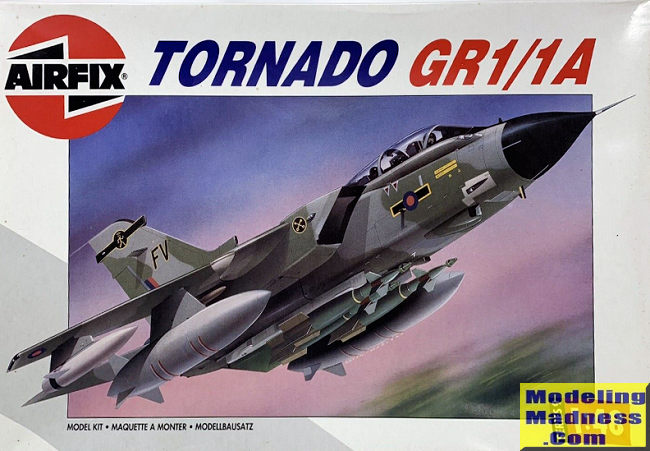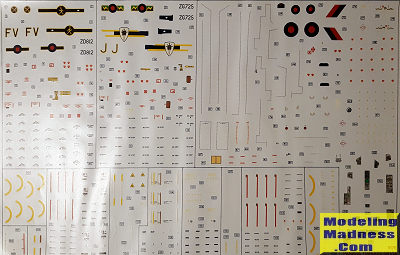
Airfix 1/48 Tornado GR.1/1A
| KIT #: | 09176 |
| PRICE: | ~$35.00 when new |
| DECALS: | Two options |
| REVIEWER: | Scott Van Aken |
| NOTES: | Xtradecal 48144 |

| HISTORY |
The Panavia Tornado is a family of twin-engine, variable-sweep wing multirole combat aircraft, jointly developed and manufactured by Italy, the United Kingdom and West Germany. There are three primary Tornado variants: the Tornado IDS (interdictor/strike) fighter-bomber, the suppression of enemy air defences Tornado ECR (electronic combat/reconnaissance) and the Tornado ADV (air defence variant) interceptor aircraft.
The Tornado was developed and built by Panavia Aircraft GmbH, a tri-national consortium consisting of British Aerospace (previously British Aircraft Corporation), MBB of West Germany, and Aeritalia of Italy. It first flew on 14 August 1974 and was introduced into service in 1979–1980. Due to its multirole design, it was able to replace several different fleets of aircraft in the adopting air forces. The Royal Saudi Air Force (RSAF) became the only export operator of the Tornado in addition to the three original partner nations. A tri-nation training and evaluation unit operating from RAF Cottesmore, the Tri-National Tornado Training Establishment, maintained a level of international co-operation beyond the production stage.
The Tornado was operated by the Royal Air Force (RAF), Italian Air Force, and RSAF during the Gulf War of 1991, in which the Tornado conducted many low-altitude penetrating strike missions. The Tornados of various services were also used in the Bosnian War, Kosovo War, Iraq War, in Libya during the 2011 Libyan civil war, as well as smaller roles in Afghanistan, Yemen, and Syria. Including all variants, 990 aircraft were built. RAF aircraft have been retired with the type soldiering on with Germany, Italy, and Saudi Arabia, at least for the near future.
| THE KIT |
The overall impression is of a nicely molded, though somewhat 'soft' appearance to the parts. The kit provides an adequate cockpit along with a pair of crew figures to fit into the seats. Decals are used for instruments. Early in the build one assembles the wings and tailplanes as they need to be attached together in order to function once the trapped in the fuselage, which happens pretty early in the build.
The only difference between the GR.1 and GR.1A is that the
latter has a camera pod on the lower fuselage under the cockpit and has no
internal gun.
One can pose the speed brakes extended if one wishes, though they were more often closed when parked on the ramp. Landing gear and exhaust are next followed by the gear doors, various scoops and antennas along with the air refuelling probe, which can also be posed extended or retracted.
Then we have the myriad of things under wings. Airfix
provides two different si
| CONCLUSIONS |
Unless you are on a budget or already have this kit, you'll be seeking the Revell version. I'd recommend staying away from the ESCI version (reboxed by Italeri), as it is just not a good fitting kit. This one might not be so bad and there are aftermarket parts out there to improve the detail.
| REFERENCES |
https://en.wikipedia.org/wiki/Panavia_Tornado
October 2022
Copyright ModelingMadness.com. All rights reserved. No reproduction in part or in whole without express permission from the editor.
If you would like your product reviewed fairly and fairly quickly, please contact the editor or see other details in the Note to Contributors.